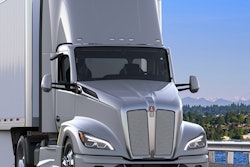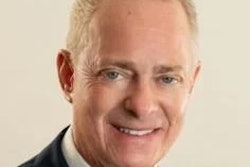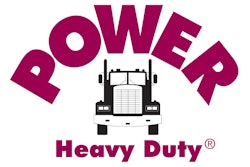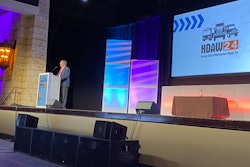
Heavy Duty Aftermarket Week's educational session on Wednesday focused on three topics chosen to fully equip attendees to move forward in 2024.
"This morning's session will expand on our 2024 theme of fully equipped by offering a look at some of the critical issues that will be keeping this industry moving forward over the next three to five years," said Mike Callison Jr., distributor co-chair. "Because in the ever-evolving landscape of the independent heavy-duty industry, staying ahead of the curve is not just a choice, but a necessity."
Trucks, Parts, Service editor Lucas Deal discussed recruitment and retention to start the session.
"[Your people] do everything that makes your business unique," Deal says. "Dale said yesterday when he was up on the stage that people are the most important part to [Distributor of the Year winner] Tidewater, and that's true for everyone in here."
Deal continued by outlining the importance of maintaining your team just like you would a truck or a piece of equipment. That means managing them well and keeping them well-informed on the market and the equipment that makes it run, as well as updating business strategies and processes.
"There's probably people on your team that recognize, 'Boy, we can do this faster,' or 'There's an easier way to do this,'" Deal says. "If you never change and you never acknowledge that, you're going to start frustrating people on your team. Are your people working with the best tools they can to be productive in your business?"
Managing teams well also means managing your team's time and skills. Deal says good managers make sure their workforce grows along with the business and that teams stay right-sized to accomplish business objectives. Good managers should also make sure their employees have plenty of opportunities for personal growth, possibly moving up in the company and becoming a good manager themselves.
Deal pointed out that disengaged employees can do serious damage to the bottom line.
"If your people are just showing up every day, doing the job and going home and they don't really care, or they are just doing the bare minimum to get by, it's costing your company money," he says.
Managers can keep employees engaged by ensuring their companies support their employees professionally and personally. Effective managers bear in mind the diversity of their workforce, not just racially, but also on other levels. Generationally, religiously, even tall or short, or by personality or how long they've worked with your business.
"You can't talk to everybody the same way you talk to the two or three people on your leadership team, because everybody's experiences are different," Deal says. "You have to be more accepting of the fact that some people are going to be different."
Building a better workforce and recognizing these differences begins with listening, Deal says.
"Listen to your people," Deal stressed. "Listening is arguably the most important skill for a business leader and employee loyalty is incredibly hard to sustain without it."
Be mindful of how you listen, when you listen and where you listen, he says. Make sure your employees have a voice when you discuss innovation and new strategies or processes. And good listening extends beyond the work place. Understand your employees on a personal level and keep up with what's going on at home.
"Just knowing what your people are going through out of work goes a long way," Deal says. "Personal support matters."
Flexibility plays into that as well. Deal says understanding your employees' lives and adjusting their schedules or business policies when you can goes a long way to inspiring loyalty and getting a team to do its best. And when it is time for employees to pursue a new opportunity, find the high ground and make camp.
"Petty isn't pretty," Deal says. "You can be really angry ... but that doesn't help. That just looks bad for everybody else in the business."
Next up, John Blodgett from MacKay & Company discussed trends in the electrification of commercial vehicles.
"We've been getting, as part of our outlooks and profiles of the aftermarket, from our clients, 'When is it going to include an aftermarket profile for components related to alternative-powered vehicles," Blodgett says. "The short story is there just aren't enough out there yet for us to start profiling. We need to see consistent sales with whatever the new technology is over a period of time outside of warranty so we can get a big enough pool so we can start surveying folks that own and maintain that equipment. We're just not there yet."
Since 2019, MacKay & Company has asked fleets what powers their trucks. It's almost always internal combustion, Blodgett says, even if it's biodiesel or some other fuel.
[RELATED: Fleet reps talk about where they see HD now and where it's going]
"Our latest survey, in 2023, about 98% of their fleets were powered by internal combustion engines and about 2% by alternative power," he says. "Their outlook, which 10 years from 2023 is now 2033, has gotten more aggressive in the percentage of vehicles they think will have powered by alternative power, up to about 14%."
The challenge is that MacKay surveys the fleets, attends conferences and reads the news, but there seems to be a disconnect. It doesn't seem the fleets are on the same page as the rest of the industry, Blodgett says. So the company decided to study technologies the fleets are considering for the commercial, on-highway vehicle market. That survey led to a new product, the Technology Monitor, which seeks to define fleets' steps and actions taken (or not taken) as they evaluate and consider new technologies.
This first survey will address alternative power for medium- and heavy-duty trucks and school buses. The second survey will feature on fleets' awareness, evaluation and purchase timeline plans and actual purchases of other recent and potential technologies, such as ADAS-related solutions, autonomous vehicles, regenerative braking and more.
Blodgett says the first survey showed that fleets that do run alternative power technology were reliant on grants and other subsidies to buy those vehicles.
"We asked them about what grants and incentives they got, how much that was and we then we also asked them, 'Would you have bought that vehicle if you hadn't gotten those grants or incentives,'" Blodgett says. "Eighty percent of them said, 'No, we would not.'"
He said the number isn't surprising, but it's a concern because at some point, alternative powertrains have to have a business case for the fleets to purchase it. "That's something we have to watch over time," he says.
Fleets not considering alternative power did so for a variety of reasons, Blodgett says, including not seeing a need for it at this time, not believing it would work for their application and the high cost. Fleets were also concerned about shops working with the new technology and with the resale value of the vehicle. Reasons for considering alternative power included comparing the operational cost to diesel, curiosity, pressure from customers or management or they consider it a responsibility to explore new technology.
MacKay also outlined activities that fleets may take in considering alternative technologies. There are 18 core reasons, the company found, that fit into four segments on the path to purchase: Education, you have my attention, serious consideration and commitment. Each stage has a different investment of time and resources, with commitment meaning the fleet has decided to purchase the vehicles or infrastructure and has definite plans to buy.
Battery electric leads the alternative powertrain pack in all four segments, Blodgett says. About 93% of respondents aren't "really there yet" on making a decision on purchasing. Another 7% said they were still researching, but hoped to purchase on a certain timeframe.
The report also contains fleets' predictions for future sales of various powertrains. By 2030, MacKay says, about 19% of retail sales purchase will be zero-emissions vehicles. Combined with purchases in previous years, that would be about 4% of power units operating.
"We've got a ways to go between what the regulations are, what the fleets' goals are, and where we are," Blodgett says. "This doesn't mean the path or trend line can't change, but it's got to change aggressively if we're going to get to that point."
Lastly, attendees heard an update on the battle for Right to Repair legislation. Ann Wilson, senior vice president for government affairs for MEMA; Baron Oursler, senior vice president, general counsel and secretary of FleetPride; and Lisa Forshee, senior vice president of government affairs for Auto Care.
Wilson started out by talking about the process for the federal legislation in Congress. H.R. 906, the REPAIR Act, is sponsored by Rep. Neal Dunn, R-Florida.
"We have to take our legislation and make it rise above the noise and make sure that repair access is must-pass legislation for this Congress," Wilson says.
The bill was introduced in the House, she says, then moves to the House Energy and Commerce Committee. It was then assigned to a subcommittee.
"The subcommittee is the worker bees of this committee," Wilson says. The bill has been heard twice by the worker bees, resulting in some edits and amendments. The bill was voted out of the subcommittee and is how back with the Energy and Commerce Committee.
"The House Energy and Commerce Committee has 54 members," she says. "A couple of those members are very much opposed to be. There are about 50-some members that we need to touch because we've got to get that bill out of the Energy and Commerce Committee."
Especially with the election looming Nov. 5.
Once the bill leaves the committee, it goes back to the full House for a vote, then to the Senate, which has a similar process.
"The Senate basically doesn't have any rules," Wilson says. "What we need to happen is we need to move that bill" to get it considered on the floor of the Senate, get it passed and get it to the president.
Forshee outlined the amendments and concerns Wilson mentioned. There are amendments that were amenable to all parties, Forshee says. That includes preventing the use of vehicle data for advertising; revising the ability of the aftermarket to expand the definition of vehicle-generated data; things about automated driving systems; and, lastly, amendments about data privacy. Two other amendments would completely strip heavy-duty from the bill.
"Which means if we pass the REPAIR Act, heavy-duty will still be required to rely with your old MOU and your handshake agreement with the OEs," Forshee says. "We cannot win this fight without you ... letting your elected officials know that removing heavy-duty from this bill is not acceptable. Without your voice, there is a very real risk that this bill would move forward without the protections that you need."
Oursler called the movement to remove heavy-duty from the bill "significant."
"Guys, we don't want HD to be left out in the cold," he says. "It's critical that the heavy-duty aftermarket get active."
He went on to outline state Right to Repair efforts in Massachusetts of Maine, and then into efforts by FleetPride and HDA Truck Pride, among others, to support the federal legislation. The companies held events and has engaged both employees and customers in the fight for H.R. 906, as well as people in related in other industries.
The trio also urged the audience to complete an online form to send letters to legislators to support the Repair Act.
"Success isn't batting 1,000. Not everyone we talk to is going to get on board," Oursler says. "Success is engaging. Success is affording folks the ability to get educated on the issue and decide whether or not they're going to stand up and participate in the Right to Repair."
The nation's largest used car dealership has sent a letter to Congress, Oursler says, and FleetPride held 25 meetings with Congress members and their staffs. A FleetPride location in Tennessee also hosted Rep. Diana Harshbarger, R-Tennessee, on Tuesday, spending an hour with her and acquainting her with the heavy-duty industry. Harshbarger is a member of the House Energy and Commerce Committee.
"This all sounds like a lot, but it is all made easier with your trade associations," Oursler says. "The next few weeks are critically important for Right to Repair as. it concerns our industry. Our opponents are vocal and they're active. We have to be vocal, too. If we don't stand up, then no one else will. The time is now."










